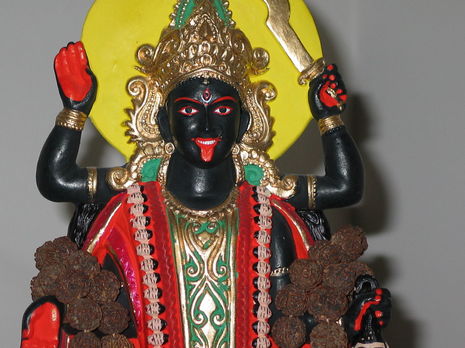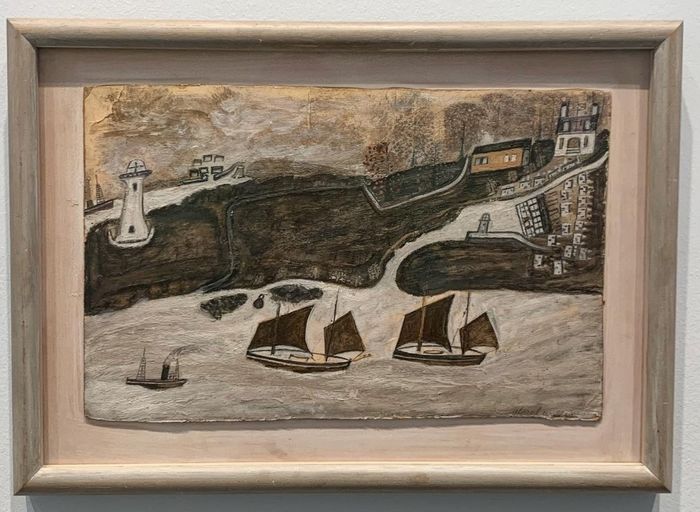Kali: Goddess and Revolutionary
Jessica Raja-Brown explores the Hindu goddess Kali as an enduring symbol of resistance against British imperialism.

The word ‘loot’, as noted by William Dalrymple in The Anarchy, was one of the first Indian words to enter the English language. The British Museum, full of such imperial plunder, often fails to wrestle with its history. One of its current exhibitions, entitled Tantra: Enlightenment to Revolution, addresses the museum’s complex relationship with British imperialism in India. In it, the provenance of the objects (all too often ignored) is noted.
The exhibition confronts the Western misunderstanding of ‘Tantra’ as a mere sexual practice by addressing its origin as a philosophy which informed Hinduism and Buddhism in medieval India. The term ‘Tantra’ is derived from the Sanskrit verbal root ‘tan’ (meaning ‘weave’); in Hinduism, ‘Tantra’ refers to the dialogue between God and Goddess.
"Kali again signifies resistance, in this case against patriarchy and white supremacy"
In this exhibition, the curator Imma Ramos explores ways in which Tantric objects were instrumental in the fight against British colonialism. Kali, the Goddess of death and time, is both a protective mother and a revolutionary icon for her devotees. At the end of the 19th century, Bengal was an important centre for the worship of Kali, and also the base for the British imperial project in Calcutta (now Kolkata). A clay figure of Kali dancing on Shiva’s body, originating in Bengal, is a manifestation of the creation and sustenance of the universe in Hinduism. Shiva, an embodiment of human consciousness, is portrayed as nothing without the divine. Worshipping Kali can lead to spiritual enlightenment; in particular, devotees are drawn to her compassion and divine feminine energy (‘shakti’), which is the core of Tantric worship.
But Kali was not understood by the British in such terms. The clay figure was donated to the British Museum in 1894, most likely by a Christian missionary in India. For missionaries, Kali represented their worst fears about Indian religions, and it was this fear that led to the misrepresentation of the goddess as a demonic figure. Set up as the antithesis to what they considered to be a superior Christian God, Kali played into their idea that they must ‘civilise’ Bengali people by converting them to Christianity.

The Bengali independence movement exploited the British fear of Kali and her devotees. Images of Kali were adapted to portray the British as enemy: one of the 1885 prints showed Kali with a necklace made of decapitated heads, and when the colonial officer identified these heads as those of the British, the image was censored. Kali became a symbol of resistance, a personification of ‘Mother India’ fighting for freedom from British rule. Revolutionary pamphlets invoked Kali’s bloodthirsty appetite and her craving to sacrifice ‘white goats’ (Englishmen). By the beginning of the 20th century, Kali had become a primary symbol of the threat to British domination. Kali’s image was used as the frontispiece for a 1907 report on the emerging nationalist movement, Ker’s Political Trouble in India. Indeed, the 1911 shift of the capital of India (from Calcutta to Delhi) was partly in response to the rising nationalist movement in Bengal.
The exhibition also explores the continuing influence of Kali in contemporary art. For British Bengali artist Sutapa Biswas, whose work will be displayed in a retrospective at Kettle’s Yard next year, it is Kali in all her vengeance who is the spirit behind the painting Housewives with Steak Knives (1985). Biswas’s Kali flies a flag featuring Artemisia Genteleschi’s painting, Judith Slaying Holofernes. Kali also appears to be holding a blank eyed mask of what we assume to be a white patriarch, and her necklace is made of some recognisable 20th century dictators’ heads. Created while Biswas was studying at Leeds Art School against a backdrop of Thatcherism and apartheid, Kali again signifies resistance, in this case against patriarchy and white supremacy.
And it is Kali again who crowns this year’s installation on Tate Britain’s facade: British Punjabi artist Chila Burman’s Remembering a Brave New World masks the statue of Britannia, a symbol of imperial glory. Burman reminds us that the legacy of British colonialism endures – the apt aphorism on Burnam’s family ice cream van resonates: ‘We are here because you were there’.
 News / Caius mourns its tree-mendous loss23 December 2025
News / Caius mourns its tree-mendous loss23 December 2025 News / Clare Hall spent over £500k opposing busway 24 December 2025
News / Clare Hall spent over £500k opposing busway 24 December 2025 Comment / The ‘class’ of Cambridge24 December 2025
Comment / The ‘class’ of Cambridge24 December 2025 Comment / Yes, I’m brown – but I have more important things to say22 December 2025
Comment / Yes, I’m brown – but I have more important things to say22 December 2025 Interviews / Politics, your own way: Tilly Middlehurst on speaking out21 December 2025
Interviews / Politics, your own way: Tilly Middlehurst on speaking out21 December 2025








